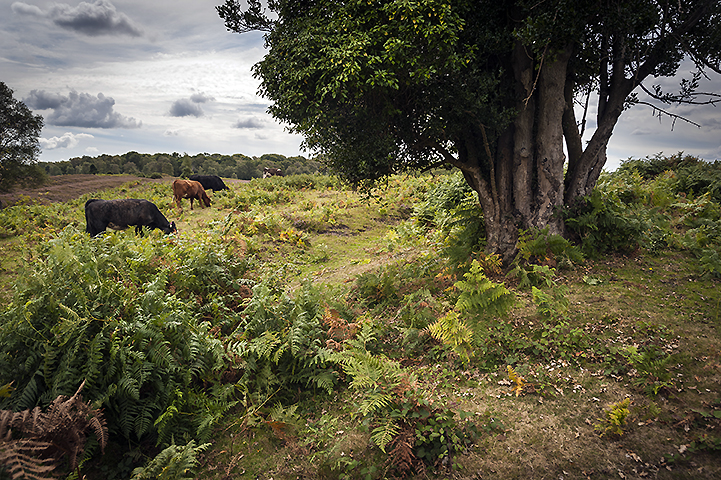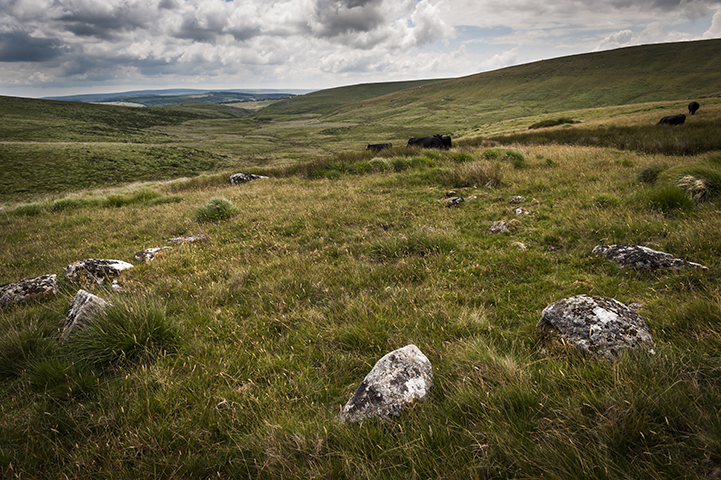
Looking south east from the road. This is either an enormous barrow standing some six metres high or a very tiny barrow on top of a small hill. Unfortunately it appears to be in someones private field so we’ll have to wait on that one.

Looking south east from the road. This is either an enormous barrow standing some six metres high or a very tiny barrow on top of a small hill. Unfortunately it appears to be in someones private field so we’ll have to wait on that one.


The recently cleared largest barrow looking north east.

Stood on top of the largest barrow with the three other nearby barrows to the south west.

The largest barrow from the track beside it.

The three large sarsens near the Alfriston Clergy House.


Large stone next to the entrance of the Alfriston Clergy House on the Tye.

The only large stone I could find built into the retaining wall.

Close-up of the stone in the retaining wall. Looks more like sandstone than a sarsen.

The back of the church looking South West. Considering how high and close it is to the Cuckmere, was the mound once an island?

The church on its mound looking North East.
It’s difficult to wander around here and not think that it must have been an ancient site. There are give-away signs almost everywhere you cast your eyes. Firstly there’s the church built on an almost circular mound with its stout flint retaining wall and then you notice its proximity to the Cuckmere River built in a bend which could almost have formed an oxbow lake. Possibly more than 2000 years ago it was an island, this being a low lying and marshy area, giving more weight to the idea of it being a sacred place. Within the retaining wall on the Eastern side is a large stone, though I’m not sure if it’s a sarsen, as it looks more like a piece of sandstone. A few metres from that is another large stone, definitely a sarsen, laying next to the entrance of the Old Clergy House (the first ever NT property). Unfortunately I couldn’t get a clear photo of this as it was almost hidden by Valerian on this occasion. Just a few more metres South is a group of three sarsens nestling under some trees looking slightly neglected and unloved. I looked around the foundations of the church to see if any stones had been built into that and was surprised to discover none, although this is often the case with christianised sites. There are, however, more stones built into walls and buildings around the village.
Stumbled on this small charming enclosure while ambling around the New Forest. It’s not very big, popular with local bovine herds, probably no more than about 20-25m in diameter and the banks no more than 1.5m high (mostly on the southern side). I imagine in the winter months it’s probably very boggy around here and the northern and eastern sides are bounded by the beginnings of the Beaulieu River which acts as a natural defence. Pastscape describes the earthwork as a Bronze Age enclosure or early Iron Age univalate Fort. I’d go for the former as the earthworks don’t seem like they were ever defensive and more about preserving a bit of dry ground in a very flat area. There are also a number of (presumably) Bronze Age barrows nearby which might support that.
Another interesting feature about a mile to the west is Row Hill which has 3, or possibly 4, long mounds on top of it. These are quite substantial, the biggest being about 2m high and about 15m long all running parallel. I’ve no idea how old they might be and would hesitate to call them long barrows. WW1 activity in the forest might be one explanation for their presence as there are currently notice boards all over the place warning you against straying from the path due to unrecovered ordnance. After a hundred years – I ask you?!

Entrance/exit on the western side. We soon realised we’d walked into a cow ambush.


Note ridges in central background. Not sure if these are part of a trackway or field system or how they relate to the enclosure.



On the northern side there’s not much in the way of ‘defensive’ earthworks just a slight rise in the ground level, but the river and bogs would probably have sufficed.

Back round to the western entrance where the bank and ditch start to kick in again.

Panorama looking north-west towards Sheepstor.

Hint of a stone avenue going on here on the western side, but it doesn’t go far.


A robbed out cairn just south-east of the circles.

Panorama looking eastish on what was quite a miserable wet day on the moor.

One of the larger stones with quite obvious drill holes. It seems this circle has been quite mauled in the past.

Panorama looking broadly north. The stone with the drill holes is in the foreground to the right.




Looking north with Fernworthy forest to the north east.

Stannon Tor beyond to the south east. These hut circles are about the nearest habitations to the Greywethers less than half a mile due north. Maybe these and other nearby groups helped to build the double circle?

Looking south.


A great little circle on a perfect day. Mrs. Cane sits on guard in the background.

Monumental clouds and slightly less than monumental stones, but charming all the same.

Looking NW with what appeared to be part of a cist/cairn in the foreground.


Shame it isn’t out on a wild and wind-swept bit of moorland, but hey, isn’t it a wonder to behold?!


Looking west and bringing out it’s mushroom-like quality.

Anyone else noticed this raised edge before? It’s sort of rectangular, but only just noticeable. Is it contemporary with the dolmen or maybe built later as a way of isolating the site to preserve it?

Pan looking south east from the way up from the car park. The banks and ditches are more prominent on this side.

Long shot looking south east. The Seven Barrows site is in the top right corner straddled by the A34.

Pan of the southern entrance leading down to ancient field systems.


Carnarvon’s rather plain grave set in a rather wonderful place.

My memory takes me back to 1972 and I have just queued up with my family for what seems a lifetime on a drab day outside the British Museum. We have just managed to get into the room where the treasures of Tutankhamun are on show and I am finally in front of the famous death mask taking in the awesomeness of it all, when an over zealous mother elbows me out of the way and thrusts her own children forward, the brief vision now fading away in a milieu of struggling families. Goodness, it was like a rugby scrum in there!
Forty two years later I’m walking around the top of Beacon Hill towards the grave of Lord Carnarvon, sponsor of Howard Carter’s 1922 excavation in the Valley of the Kings. It’s a beautiful day and being a Monday there’s hardly a soul about, just the ever present hum of the A34 a long way below me. The last time I came up here must have been before 1972 when my parents would bring us here for a Sunday afternoon runabout and tell us about the Tutankhamun stories. It’s all pretty much as I remember it, the grave surrounded by railings, the view to Highclere Castle, the stout earthworks of the hill fort, the wild flowers and butterflies and the singing of skylarks above. In fact the only thing that has changed is the A34 which must have been a very quiet affair pre-1972. It’s the A34 that got me back here as well, having travelled up and down it on numerous occasions, always strongly aware of the hill’s presence, but it was always a case of ‘in too much of a hurry, not the right weather or nobody else in the car wanting to do the mammoth climb to the top’. Well today is my day and all the conditions are spot on.